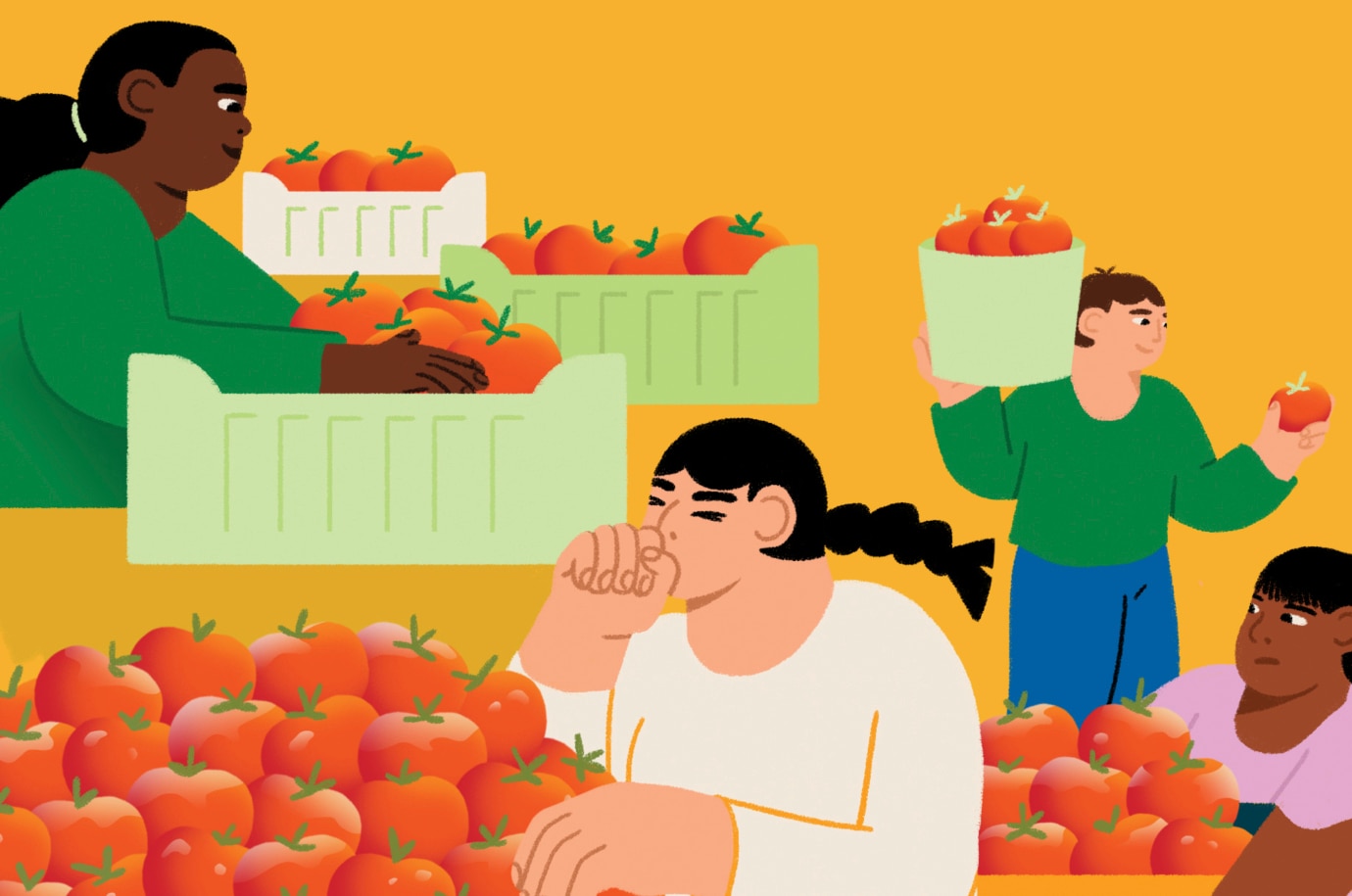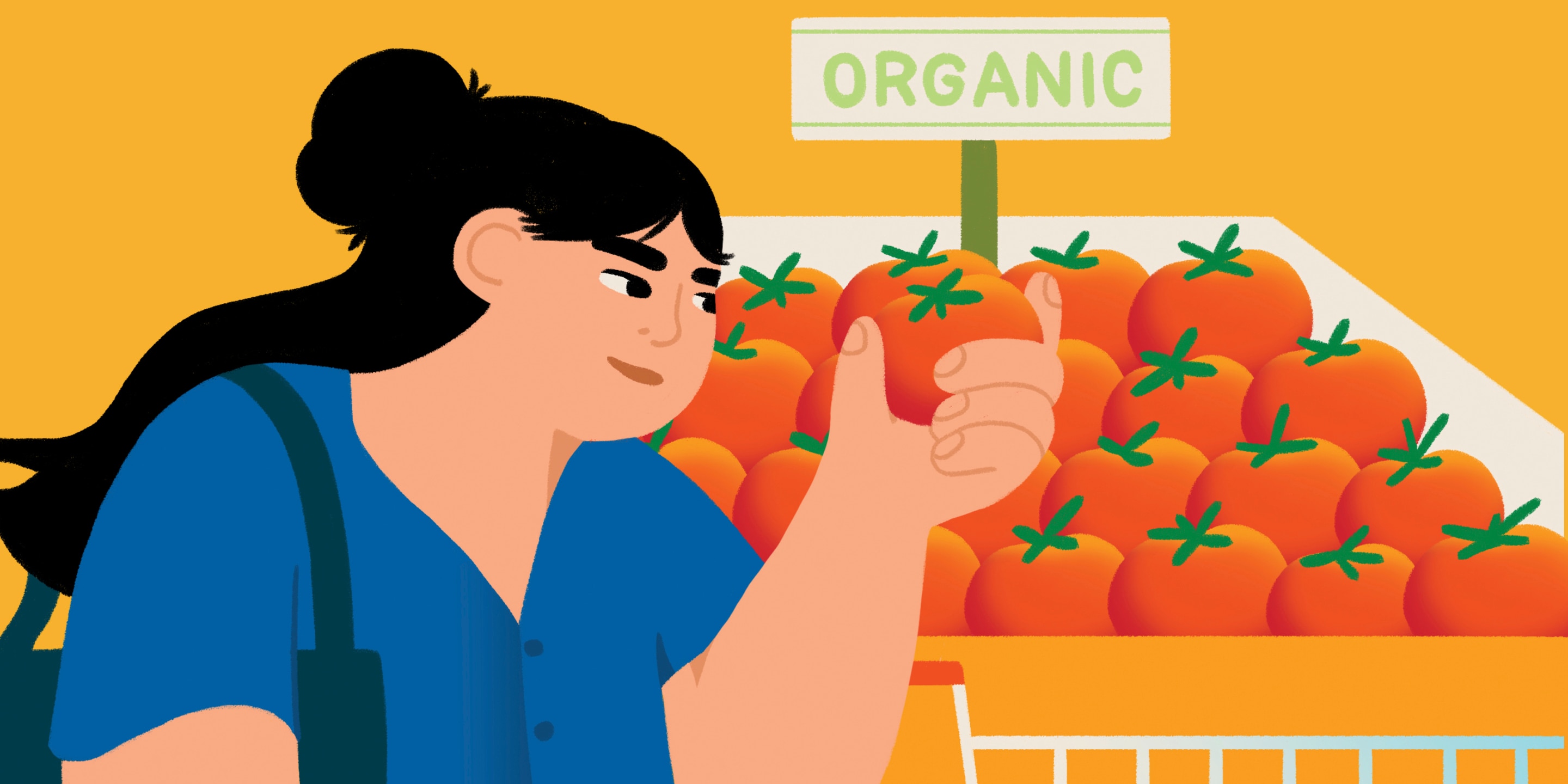Integrity report
Why the organic movement fails the people who make it possible
Words by Chloe-Rose Crabtree
Illustration by Janice Chang/Studio PI
In the United States, the push for organic farming is driven by consumer demand. The organic label has grown into an aspirational lifestyle, complete with an aura of healthfulness that directs consumer interest toward products based on their individual concerns. But organic farming methods have the ability to improve health far beyond the people buying the products. Instead, more focus must be directed at benefitting people working within the supply chain. Because as things stand, it is continuing to fail them.
First, some background. Only 40 years ago, organic farming was seen as a fringe movement in the US. Advocates wanted to move conventional farming away from pesticide use and chemical fertilizers. But conventional farmers, as well as the United States Department of Agriculture (USDA), were concerned that the low-intervention methods associated with organic farming would result in lower crop yields. This was a devastating prospect for an industry with already low profit margins.

But, in 2002, the USDA implemented a process for farms to receive organic certification. Today, to qualify for this, a farm must implement organic methods for a three-year period and receive inspection from a private certifying agent approved by the USDA. The cost of the certification process can range anywhere from a few hundred dollars to a few thousand. Regulations also control who can use ‘organic’ in their marketing materials.
Because of the cost, smaller farms that use organic methods are often barred from the certification process, simply because the price is too high. In this sense, the marketing focus on consumer health actively obscures the wider impact that the organic movement could have in improving the health of its workers.
But why is that? Well, when it comes to food production in the US, the health of the consumer has been the main focus since the Pure Food and Drug Act of 1906. Passed after journalist Upton Sinclair published his novel The Jungle, which detailed poor living and working conditions
faced by immigrant laborers in Chicago’s meat-packing industry, the law set the precedent for what is now the Food and Drug Administration.
Sinclair’s intention was to make Americans more sympathetic to trade unions and the socialist movement, in the hopes that they would be compelled to improve the working conditions he detailed in the book. Instead the public was more appalled by how these conditions contributed to potential contamination of the food they ate. Sinclair famously said of The Jungle, “I aimed at the public’s heart and by accident I hit it in the stomach.”
The novel hit on a growing concern. Following the rapid urbanization of the latter half of the 19th century, more Americans relied on purchasing food rather than farming it themselves, or having a direct relationship with a farmer. In 1800, roughly 94 per cent of Americans lived in a rural setting. By 1900, that had dropped to 60 per cent. The American workforce now found itself concentrated in urban centers, where long hours made it difficult, if not impossible, for people to produce and grow their own food. Industrial food production went from a thing of novelty to a matter of necessity.
With The Jungle, Sinclair’s aim was to point out that industrial practices allowed for the exploitation of (largely immigrant) labor, which in turn led to lax health standards. But growing anti-union and anti-immigrant sentiment in the United States meant the public was not very sympathetic to this message. Instead, small food producers were now eyed with suspicion while those with a budget to advertise took the opportunity to prove the ‘purity’ of their goods. Heinz, for instance, launched factory tours where the public was invited to watch attractive women can products in a lab-like environment—the rest of the supply chain remained obscured.

In 2021, the focus of safety when it comes to food production remains turned on the consumer. Organic foods in particular receive a halo of health that associates them with the wellness lifestyle that dominates social media. Sinclair’s assertion that safer working conditions for people working within supply chains would lead to safer products also remains true. The unfortunate truth, though, is that the American consumer is trained to ignore the reality of a supply chain that exploits labor, especially when the workforce is predominantly from an immigrant background.
While the USDA provides guidelines for organic certification that regulate pesticide use, farming methods and the wellbeing of livestock, the welfare of workers employed by farms and farmers is not currently within their remit. By virtue of lowered pesticide and chemical use, organic farming offers the potential for better working conditions for farm workers at risk of diseases caused by pesticide and chemical exposure. But until recently, farm workers weren’t even granted federal minimum wage protections. Even today, minimum wage isn’t federally mandated for small farms and farm workers in general are not entitled to overtime pay.
Instead, farm-worker income is mainly dictated by how fast they can work. In many cases people are paid by piece (i.e. how many buckets of tomatoes), which encourages workers not to take breaks or risk losing out on precious income. “For cherry or grape tomatoes they pay us $5 a bucket,” says Vianey Lopez, a farm worker based in Florida. “For each bucket you recieve a little coin or a little ticket. At the end of the day they count them and that’s what you get paid.”
In Lopez’s experience, this work isn’t paid differently on organic or conventional farms, but the level of focus needed for organic harvests means the work cannot be done as quickly. “When you pick non-organic, it’s just whatever. You pick whatever tomato comes in and put it in the bucket. With organic they’re really strict. If they only want us to pick red tomatoes we have to pick specifically red tomatoes, or if they want reddish with a little yellow, we can only pick those.”
The extra time workers like Lopez take to select these specific tomatoes ultimately cuts into
the overall yield they harvest individually each day, which Lopez says can negatively affect how much she is paid. A lower payout at the end of the day can be devastating, so workers are less incentivized to work on organic farms, despite the health risks associated with chemical exposure on non-organic farms.
Lopez tells a story of a woman that once suffered an allergic reaction to the chemicals, which was so severe that it affected her breathing. The employer’s response? “When the crew leader came down, the only thing he told her was, basically, if she’s allergic to not come back. And when I spoke to the lady [who suffered the attack] she basically said this was the only job she could find.”
Lopez also notes that while the employer eventually did call an ambulance, there were no direct health services provided by the employer to help her colleague.
In addition to physical health concerns, the instability of farm work also impacts workers. Many live in temporary housing on farms during harvests and find themselves moving multiple times a year depending on where their work takes them. Meanwhile, the introduction of the H2-A temporary worker visa for foreign agricultural laborers can also make it difficult for those residing in the US to gain steady employment.
Major agricultural employers are incentivized to employ H2-A visa holders as they are not required to pay taxes or unemployment for them. These workers also tend to come without their families, meaning housing costs can be significantly cheaper.
The aforementioned cost of organic farming methods and certification, as outlined by the USDA’s organic program, prioritize access for larger farms that are unlikely to change their employment practices without regulatory intervention. While their packaging touts the increased health and environmental benefits of organic products, the back-breaking work of farming and employment instability is still obscured from the consumer.
Small farms, where farmers are more likely to work alongside farmworkers and provide better living and working conditions, find slim profit margins constrain how much labor they can afford. As a result, many smallscale organic farms rely on WWOOFers (an international network of people who volunteer their time to work on a farm in exchange for room and board), or interns who are paid with stipends by outside organizations. This offers some economic reprieve for the farmer, but does little to improve working conditions across the industry.
While health concerns are one of the major factors that drive consumers towards organic purchases, we must reflect more on the health of people within the supply chain—the people who make it possible. Their physical well-being can be better protected when it comes to decreased contaminant exposure and regulated breaks, but we should also be concerned with improving the mental health of our farm workers as well: which comes in the form of better pay, increased job stability and a clear path to labor protections.



